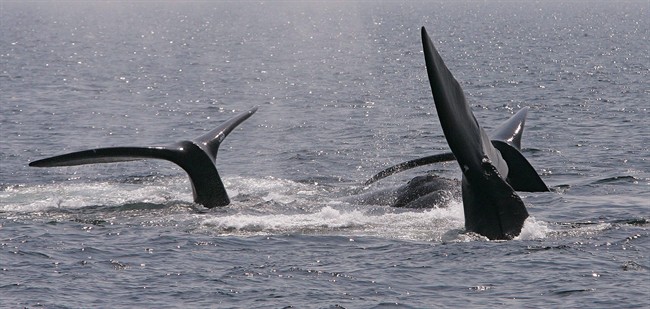An entangled North Atlantic right whale spotted in the Bay of Fundy is proving elusive for rescue crews trying to find it.

Heavy fog forced searchers to suspend their hunt Tuesday, a day after it was spotted 22 nautical miles east of Grand Manan, N.B.
“Weather conditions deteriorated throughout the morning and the search was postponed due to weather on scene,” the Department of Fisheries and Oceans said in a release Tuesday afternoon.
Jerry Conway of the Campobello Whale Rescue Team said the whale, identified as an adult male, was seen Monday morning with an orange buoy trailing behind it.
“We’re guessing that the line is entangled on a lower portion of the whale and there must be a weight attached to that line to keep it submerged except for the buoy that’s on the surface,” he said.
READ MORE: New Brunswick whale rescue team frees first entangled whale since team member’s death

Get breaking National news
Three rescue boats had been on the water Tuesday morning, while a Fisheries and Oceans aircraft surveyed from above.
Conway said his group, federal fisheries officials, as well as crews from the New England Aquarium and the Grand Manan Whale and Seabird Research Station will continue searching.
Fisheries and Oceans said the forecast shows continued poor weather for the next two days.
“Weather permitting and visibility permitting we’ll go out until we find the whale and try to disentangle it,” Conway said.
Freeing a whale from fishing lines can be very dangerous.
Joe Howlett died during the rescue of a North Atlantic right whale on July 10, 2017. Howlett and Mackie Greene helped found the Campobello team in 2002, and the organization has rescued about two dozen whales over the past 15 years.
Fisheries and Oceans has taken a number of measures since then in an effort to limit the number of whales that become entangled.
There have been speed limits imposed on vessels in some areas, there are new regulations on the use and identification of fishing gear, and a number of fishing zones have seen temporary closures as a result of whales spotted in the area.
The increased measures follow the deaths of 18 North Atlantic right whales in Canadian and U.S. waters last year – most of them in the Gulf of St. Lawrence – mainly due to collisions with ships or entanglements in fishing gear.
There are believed to be fewer than 450 of the whales remaining and, of those, there are only about 100 breeding females.













Comments